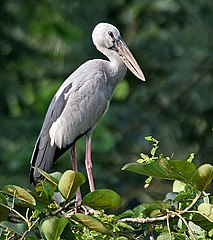Anastomus
| Anastomus[1] | |||
| Bonnaterre, 1791[2] | |||
 Przedstawiciel rodzaju – kleszczak azjatycki (A. oscitans) | |||
| Systematyka | |||
| Domena | |||
|---|---|---|---|
| Królestwo | |||
| Typ | |||
| Podtyp | |||
| Gromada | |||
| Podgromada | |||
| Infragromada | |||
| Rząd | |||
| Rodzina | |||
| Rodzaj |
Anastomus | ||
| Typ nomenklatoryczny | |||
|
Ardea oscitans Boddaert, 1783 | |||
| Synonimy | |||
| |||
| Gatunki | |||
| |||
Anastomus – rodzaj ptaków z rodziny bocianów (Ciconiidae).
Zasięg występowania
Rodzaj obejmuje gatunki występujące w Azji i Afryce[11].
Morfologia
Długość ciała 80–94 cm; masa ciała 1–1,3 kg[11].
Systematyka
Etymologia
- Anastomus: gr. αναστομοω anastomoō „dostarczać ustami, z szeroko otwartymi ustami”. Kleszczak azjatycki ma długi dziób z widoczną szczeliną pomiędzy górną a dolną szczęką, co jest adaptacją do spożywania ślimaków słodkowodnych[12].
- Hians (Hyans): łac. hians, hiantis „rozdziawiony, otwarty”, od hiare „otworzyć”[12]. Gatunek typowy: Ardea oscitans Boddaert, 1783.
- Rhynchochasme: gr. ῥυγχος rhunkhos „dziób”; χασμα khasma, χασματος khasmatos „szerokie otwarcie, przepaść”[12]. Gatunek typowy: Ardea oscitans Boddaert, 1783.
- Empharis: gr. εμφανης emphanēs „rzucający się w oczy”, od εμφαινω emphainō „pokazywać”; ῥις rhis, ῥινος rhinos „nos”[12]. Nowa nazwa dla Hians Dumont, 1817.
- Hiator: nowołac. hiator, hiatoris „otwarty dziób, otwarte usta”, od łac. hiatus otwarcie, otwór, od hiare „otworzyć”[12]. Gatunek typowy: Anastomus lamelligerus Temminck, 1823.
- Chaenoramphe (Chaenorhamphus): gr. χαινω khainō „ziewać”; ῥαμφη rhamphē „dziób”[12]. Gatunek typowy: Ardea oscitans Boddaert, 1783.
- Apertirostra: łac. apertus – otwarty, od aperire „odkryć”; rostrum „dziób”[12]. Gatunek typowy: Ardea oscitans Boddaert, 1783.
Podział systematyczny
Do rodzaju należą następujące gatunki[13]:
- Anastomus oscitans (Boddaert, 1783) – kleszczak azjatycki
- Anastomus lamelligerus Temminck, 1823 – kleszczak afrykański
Uwagi
Przypisy
- ↑ Anastomus, [w:] Integrated Taxonomic Information System (ang.).
- ↑ P.J. Bonnaterre: Tableau encyclopédique et méthodique des trois règnes de la nature. Ornithologie. Paris: Chez Panckoucke, libraire, Hôtel de Thou, 1791, s. xciii. (fr.).
- ↑ B.G de Lacépède: Methode. W: F.M. Daudin: Traité élémentaire et complet d’ornithologie, ou, Histoire naturelle des oiseaux. T. 1. Paris: Chez l’Auteur, Duprat, 1800, s. 436. (fr.).
- ↑ J. Fischer von Waldheim: Das Nationalmuseum der Naturgeschichte zu Paris: von seinem ersten Ursprunge bis zu seinem jetzigen Glanze. Cz. 2. Frankfurt am Main: Fridrich Esslinger, 1803, s. 195. (niem.).
- ↑ J. Hermann: Observationes Zoologicae: quibus novae complures, aliaeque animalium species describuntur et illustrantur. Argentorati: Amandum Koenig, 1804, s. 156. (łac.).
- ↑ C.S. Rafinesque: Analyse de la nature, or, Tableau de l’univers et des corps organisés. Palerme: Aux dépens de l’auteur, 1815, s. 70. (fr.).
- ↑ Ch. Dumont: Dictionnaire des sciences naturelles, dans lequel on traite méthodiquement des différens êtres de la nature, considérés soit en eux-mêmes, d’après l’état actuel de nos connoissances, soit relativement à l’utilité qu'en peuvent retirer la médecine, l’agriculture, le commerce et les artes. Suivi d’une biographie des plus célèbres naturalistes. T. 8. Strasbourg; Paris: F. G. Levrault; Le Normant, 1817, s. 51. (fr.).
- ↑ H.G.L. Reichenbach: Avium systema naturale. Das natürliche system der vögel mit hundert tafeln grösstentheils original-abbildungen der bis jetzt entdecken fast zwölfhundert typischen formen. Vorlaüfer einer iconographie der arten der vögel aller welttheile. Dresden und Leipzig: Expedition der vollständigsten naturgeschichte, 1850, s. xii. (niem.).
- ↑ G.R. Gray: Catalogue of the genera and subgenera of birds contained in the British Museum. London: The Trustees, 1855, s. 115. (ang.).
- ↑ O. Salvin & P.L. Sclater. Notices of recent Ornithological Publications. „Ibis”. Fourth Series. 2 (8), s. 482 (przypis), 1878. (ang.).
- ↑ a b A. Elliott: Family Ciconiidae (Storks). W: J. del Hoyo, A. Elliott & J. Sargatal (red.): Handbook of the Birds of the World. Cz. 1: Ostrich to Ducks. Barcelona: Lynx Edicions, 1992, s. 458. ISBN 84-87334-10-5. (ang.).
- ↑ a b c d e f g Etymologia za: The Key to Scientific Names, J.A. Jobling (red.), [w:] Birds of the World, S.M. Billerman et al. (red.), Cornell Lab of Ornithology, Ithaca (ang.).
- ↑ Systematyka i nazwy polskie za: P. Mielczarek & M. Kuziemko: Rodzina: Ciconiidae Sundevall, 1836 - bociany - Storks (Wersja: 2015-09-05). [w:] Kompletna lista ptaków świata [on-line]. Instytut Nauk o Środowisku Uniwersytetu Jagiellońskiego. [dostęp 2018-03-20].
